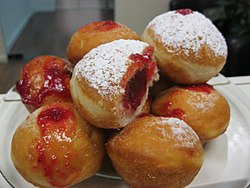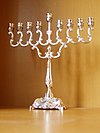Sufganiyah
 Classic Hanukkah sufganiyot filled with strawberry jelly | |
| Type | Doughnut |
|---|---|
| Place of origin | Israel |
| Main ingredients | Dough, jelly or custard, powdered sugar |
A sufganiyah (Hebrew: סופגנייה or סופגניה; plural, sufganiyot: סופגניות, pronounced SOOF-gah-nee-AH, SOOF-gah-nee-OHT) is a round jelly doughnut eaten in Israel and around the world on the Jewish festival of Hanukkah. The doughnut is deep-fried, filled with jelly or custard, and then topped with powdered sugar.[1] At Hanukkah, Jewish people observe the custom of eating fried foods in commemoration of the miracle associated with the Temple oil.
History
The Hebrew word sufganiyah and Arabic word sfenj derive from the words for sponge (sfog, Hebrew: ספוג;[2] isfanj, Arabic: إسْفَنْج).
There is a long North African history besides the Jewish tradition of associating sfenj (the smaller, deep-fried donuts) with Hanukkah. In Israel, where Central and East European Jews mingled with North African Jews, the Yiddish ponchkes (similar to the German Berliner, the Polish pączki, or the Russian ponchik) became part of this tradition.[3]

The ponchke-style sufganiyah was originally made from two circles of dough surrounding a jelly filling, stuck together and fried in one piece.[1] Although this method is still practiced, an easier technique commonly used today is to deep-fry whole balls of dough, similar to the preparation of sfenj, and then inject them with a filling through a baker's syringe (or a special industrial machine). This method has resulted in the modern sufganiyah being identical to the German Berliner.[citation needed]
Bakeries and grocery stores build excitement for the approaching holiday by selling sufganiyot individually and by the box; they have become a favorite for school and office parties. Angel Bakeries, the largest bakery in Israel, reportedly fries up more than 250,000 sufganiyot every day during the eight-day Hanukkah festival. Each batch uses 100 kilograms of dough and makes 1,600 sufganiyot.[4] Local newspapers add to the excitement by sending out food critics each year to rate the "best sufganiyah in town."
As a result of the national hubbub, some purveyors have elevated the basic filling recipe to an art form. The least expensive version (priced at about $0.30) is filled with plain red jelly, while more expensive versions (priced at up to $3 per sufganiyah) are piped with dulce de leche, chocolate cream, vanilla cream, cappuccino,[5] and even araq, and topped with various extravagant toppings, from coconut shavings to meringue and fruit pastes.[6] In 2014 one Jerusalem bakery produced sufganiah dough saturated with Van Gogh Vodka.[7]
In recent years, Israeli bakeries began downsizing sufganiyot to appeal to health-conscious consumers. The usual 100 grams (3.5 oz) size, packing 400 to 600 calories (1,700 to 2,500 kJ),[5] now appears in 50 grams (1.8 oz) size with different fillings and toppings, earning the name "mini".[8]
Gallery
-
chocolate and vanilla cream-filled sufganiyot
-
Elegantly-styled "mini" sufganiyot
-
Sufganiyot roladin
See also
References
- ^ a b Roden, Claudia (1996). The Book of Jewish Food: An Odyssey from Samarkand to New York. New York: Alfred A. Knopf.
- ^ The New Even Shoshan Dictionary. Vol. II. p. 932.
- ^ Philologos (2009-02-04). "Polishing off Your Delicious Ponchkes". The Forward. Retrieved 2012-12-09.
- ^ Mietkiewicz, Mark (2003-12-20). "Sufganiyot". Food-Lists.com. Retrieved 2010-04-06.
- ^ a b Minsberg, Tali; Lidman, Melanie (2009-12-10). "Love Me Dough". The Jerusalem Post. Retrieved 2009-12-17.
{{cite web}}: Unknown parameter|lastauthoramp=ignored (|name-list-style=suggested) (help) - ^ Maimon, Rotem (1 December 2015). "דירוג "הארץ": מצעד הסופגניות הטובות והגרועות של השנה". Haaretz (in Hebrew). Retrieved 27 December 2015.
{{cite news}}: Unknown parameter|trans_title=ignored (|trans-title=suggested) (help) - ^ City Mouse Online (24 November 2013). "Rolling in Dough: The 8 Best Hanukkah Sufganiyot in Israel". Haaretz. Retrieved 27 December 2015.
- ^ Yefet, Orna (2006-12-04). "Hanukkah: Doughnuts go healthy". Ynetnews. Retrieved 2010-04-06.
External links
- Making non-traditional sufganiyot: a demonstration video with Phyllis Glazer
- Sufganiyot – The Best (Heb.)
- The best Hanukkah sufganiyot in Israel





